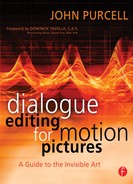Screening the OMF/PostConform—The Spotting Session
All films have directors, and we must listen to them and honor their wishes, even though any honest sound editor can recall times when he thought the director was off the mark. “If only he’d listen to me, Rome would be saved.” Get a grip. It’s not your film, and you may not be seeing the big picture. Plus, drawing blood over a breath or a chair squeak isn’t a sign of maturity. Besides, the director just may be right.
On a typical small film, you’ll meet with the director two or three times: just after the OMF or autoconform is opened and checked for accuracy, near the end of your editing, and perhaps again just before the dialogue premix. Depending on the dynamics of the sound department and the film’s budget, you may see the director more often or you may have no meetings at all with her, turning instead to the supervising sound editor for guidance.
Spotting Session Basics
The initial spotting session with the director is the most comprehensive meeting, as it involves the entire sound crew along with people from the film you may never see again. In many ways, though, it’s one of the easiest because there’s no baggage yet and expectations and spirits are often high. Most of the burden in this meeting falls on the supervising sound editor. Still, there are things you have to pay attention to.
It’s All about Listening
If this is your first time seeing the film, you’ll have to work doubly hard during the screening. You need to listen for dialogue issues (off-mic recordings, noisy settings, radio mic problems, dolly noise, etc.), and at the same time pay attention to the narrative so that you know what’s going on and can start to think about the dialogue’s contribution. Following the narrative is never really the problem—that part comes naturally. The hardest aspect of a screening is suspending the story enough so that you can notice the problems. Left to our own devices, we tend to “veg out” with the movie and fail to notice all but the most obnoxious dialogue errors.
Staying in contact with a film you’re screening and looking beyond the story are largely matters of brute-force discipline. You just have to make yourself focus. A few tricks may help.
• |
Take the best seat in the room, front row center if you’re screening on a workstation. You, more than anyone, need to hear the tracks. |
• |
Be relaxed. Find a good chair and get comfortable. |
• |
Use a form like the one in the Figure 7-1 to remember what questions to ask and what to listen for. |
• |
As each scene begins, immediately identify the room tone, the noise level, and the quality of the dialogue. Take notes if necessary. By gathering this information at the beginning of each scene, you needn’t worry if your mind wanders a bit. As soon as the scene ends, be alert for the next scene’s troubles. |
• |
Watch for moving cameras. When the camera moves there’s likely to be dolly noise or perhaps unwanted footsteps. When the camera moves up or down, there’s a good chance of camera pedestal or crane noise. It’s very easy to miss even the most scandalous dolly noise when the movie is good. Just remember: A moving camera spells trouble. |
• |
After a reel or so, pinch yourself. You may be drifting or have become waylaid by the story. It’s actually easier to screen a mediocre film than a masterpiece, since you’re less likely to be kidnapped by the plot. Films in a foreign language are even easier to study. |
Figure 7-1 An evaluation form for preliminary screenings. Use it to compile information about the client and the film, the expectations of the client, and technical details from the screening. It serves as a useful reminder of what you need to listen for during the screening.

